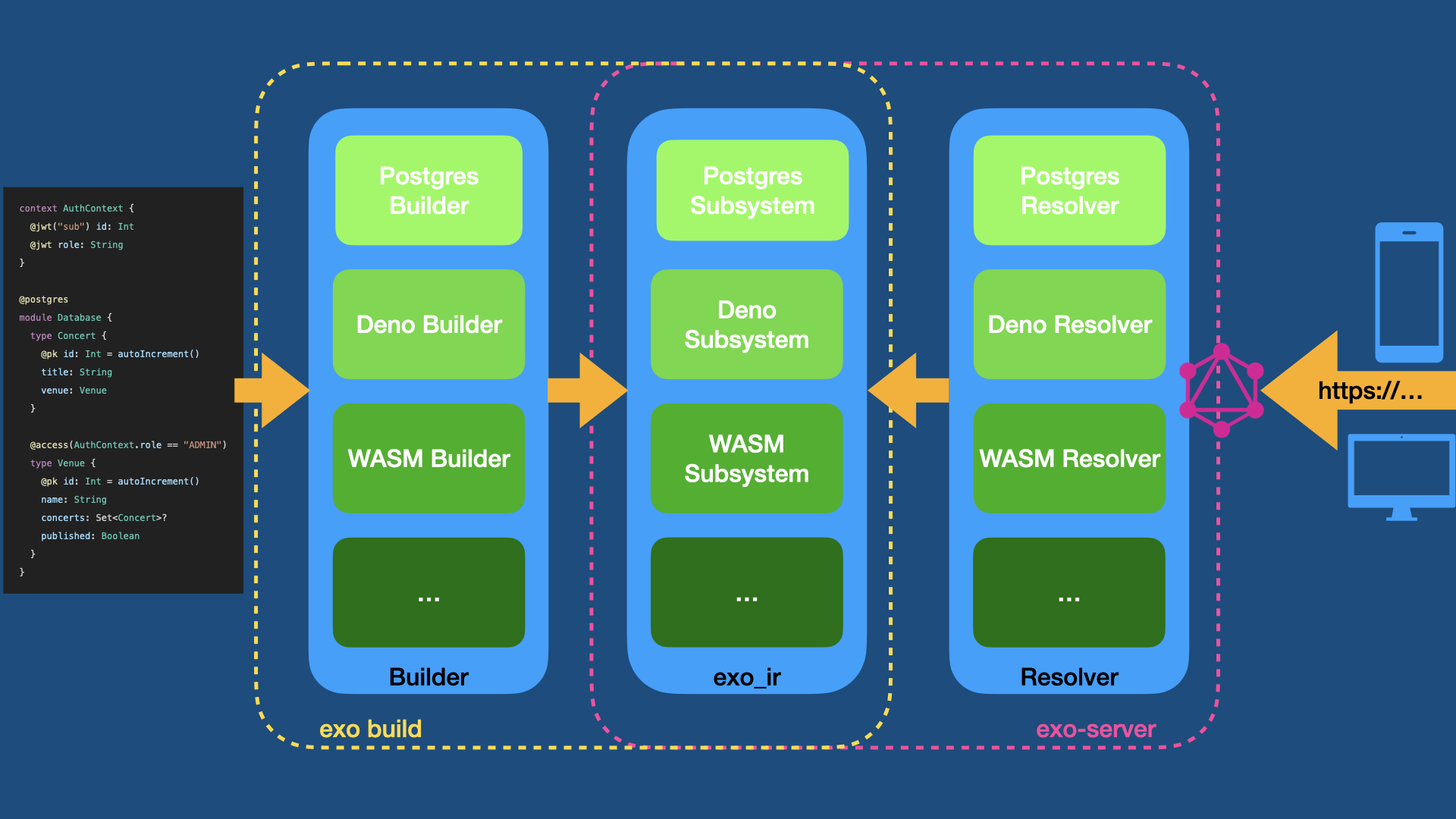Plugin System
Exograph is a plugin-based architecture where each plugin represents a subsystem and comes in two parts: builder and resolver. The builder processes the AST presented by the parser and produces a serialized representation of a subsystem to resolve queries and mutations. The resolver is responsible for loading the serialized representation and resolving queries and mutations. The content of the subsystem is entirely up to the plugin; as long as the builder can produce a serialized version and the corresponding resolver can consume it, the plugin can do whatever it wants. Even the serialization format is up to each plugin (currently, plugins shipped with Exograph use the bincode format).
The separation between builder and resolver allows to emphasize different aspects in their implementation. Builders focus on good error reporting and producing an optimized model. Resolvers, on the other hand, can assume that the model is error-free and focus on performance.
Exograph core orchestrates the overall building and resolution by delegating the bulk of work to plugins. It also provides a set of common types and utilities used by plugins.

Out of the box, Exograph includes plugins for Postgres, Deno, and (experimental) WebAssembly subsystems.
Each plugin participates in two phases: building and resolving. Let's examine each in more detail.
The build phase
When you build an exo file (by directly running exo build or indirectly through exo dev or exo yolo), the builder produces an exo_ir file (later used by the resolver). The build phase consists of the following steps:
-
Parsing: Exograph core parses the exograph file and produces an untyped AST. This AST reflects the content of the exo files. It includes types (for each
typeelement in the exo file and primitive types supported by Exograph) and contexts (for eachcontextelement). Exograph core then typechecks the AST to ensure the existence and correct usage of types, resulting in a typechecked AST. -
Subsystem Building: For each plugin registered with the system, Exograph core calls the
buildmethod on the plugin's builder, passes it the typechecked AST, and gathers theSubsystemBuildobjects returned by the builder. TheSubsystemBuildobject contains a serialized representation of the subsystem and the information needed to implement interceptions. Each plugin is free to process the AST in any way it wants. A typical plugin gathers or infers information required to form a complete model (for example, the table name associated with a database type), and compute queries and mutations supported by the model. It will also attach access control rules to queries and mutations. It may bundle external resources such as Javascript code needed by the plugin. See builder for more details. -
System Building: Exograph core then builds the overall system. It starts by processing the
SubsystemBuildobjects and produces aSerializableSystemobject. It also produces a mapping of query/mutation names to interceptors, so that interceptors can be applied when resolving queries and mutations. TheSerializableSystemobject contains a serialized representation of the entire system and the interception map. It also ensures that the system as a whole is valid. For example, it ensures that a query or mutation is uniquely defined. -
Serialization: Exograph then serializes the
SerializableSystemobject into a binary format and writes it to an "exo_ir" file.
The resolve phase
When you execute exo-server (or indirectly do so through exo dev or exo yolo), it starts a server, exposes an endpoint to receive GraphQL operations, and resolves them. This phase itself has two steps: loading and resolving.
Loading
Upon startup, the server performs the following steps:
-
Deserialization: The Exograph core deserializes the "exo_ir" file into a
SerializableSystemobject. -
Resolver formation: For each subsystem in the
SerializableSystemobject, Exograph core finds a matchingSubsystemLoaderand asks it to initialize the subsystem with the serialized representation. The subsystem loader is responsible for deserializing this representation and creating any necessary objects such as a connection pool. If GraphQL introspection is enabled, it also consults each resolver to find schema-related information and forms an introspection resolver. Finally, it combines all subsystem resolvers into aSystemResolver. -
Server setup: Exograph core starts a server and exposes an endpoint to receive GraphQL queries and mutations.
Resolving
Upon receiving an operation, Exograph core validates it and asks each subsystem resolver to resolve the validated operation. Since the builder phase has ensured that each operation is uniquely defined, it knows that only one subsystem resolver will resolve an operation.
While each subsystem resolver is free to resolve an operation in any way it wants, a typical subsystem resolver first applies the access control rules and performs the resolution logic. For example, a relational database plugin may check if the user can access the associated model and perform a database query to resolve the operation. See resolver for more details.